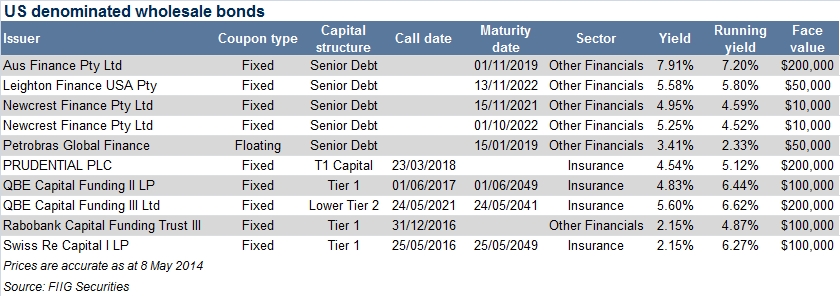by
Ekaterina Skulskaya | May 13, 2014
Key points:
- FIIG offers 66 wholesale corporate bonds through its DirectBonds service.
- There are 34 fixed rate bonds, 29 floating rate notes, two are indexed annuity bonds and one is a capital indexed bond.
- FIIG also offers 19 foreign currency bonds in small parcels including: 10 US dollar, five Great British pound and four Euro denominated bonds.
Along with the 66 wholesale Australian dollar corporate DirectBonds, FIIG also offers 19 foreign currency bonds in small parcels including: ten US dollar denominated bonds, five Great British pound and four Euro denominated bonds.
The lists below detail the 19 wholesale foreign currency bonds available. It shows the diversification possible with bonds available across industries and bond type. Eight bonds are Tier 1 hybrids (that contribute to regulatory capital) and one is a hybrid issued by Origin Energy Finance Ltd, five are senior debt, while the remaining four are subordinated debt. The Tier 1 hybrids are issued by:
- AXA SA
- Friends Life Group
- National Capital Instruments (a subsidiary of National Australia Bank)
- National Capital Trust (a subsidiary of National Australia Bank)
- Prudential Plc
- QBE Capital Funding
- Rabobank
- Swiss Re

Table 1

Table 2

Table 3
All investors are presumed to be retail investors unless they can prove they are wholesale (sophisticated or professional). Please see the “Are you retail or a wholesale Investor” article.
Common terms
Call date - the date prior to maturity on which a callable bond may be redeemed by the issuer. If the issuer determines there is a benefit to refinancing the issue, the bond may be redeemed on the call date, at par, or at a small premium to par depending on the terms of the call option.
Capital indexed bonds (CIB) – CIB’s pay a predetermined coupon based on a capitalising principal amount where the capitalisation is a function of inflation. At maturity the investor receives the capitalised face value
Capital price – also referred to as “clean price” and does not include any accrued interest.
Face value - is the initial capital value of the bond and the amount repaid to the bondholder on its maturity, usually $100.
Indexed annuity bond (IAB) – an IAB is an annuity structure where each periodic payment includes a combined coupon and principal component, known as the “base payment”. The base payment is adjusted for inflation.
Maturity - this is the date when the bond is due for repayment by the issuer. The principal plus any outstanding interest of a particular security will be repaid on this date.
Running yield - uses the current price of a bond instead of its face value and represents the return an investor would expect if he or she purchased a bond and held it for a year. It is calculated by dividing the coupon by the market price.

Yield to maturity - the return an investor will receive if they buy a bond and hold the bond to maturity. It is the annualised return based on all coupon payments plus the face value or the market price if it was purchased on a secondary market. Yield to maturity thus includes any gain or loss if the security was purchased at a discount (below face value) or premium (above face value). It refers to the interest or dividends received from a security and is usually expressed annually or semi-annually as a percentage based on the investment’s cost, its current market value or its face value. Bond yields may be quoted either as an absolute rate or as a margin to the interest rate swap rate for the same maturity. It is a useful indicator of value because it allows for direct comparison between different types of securities with various maturities and credit risk. Note that the calculation makes the assumption that all coupon payments can be reinvested at the yield to maturity rate. Also, the yield and coupon are different.
If you would like to learn more about bonds, or to discuss possible strategies, please contact your local dealer.
Note: prices and yields are accurate as at 4 April 2014, and are guide only and subject to market availability. FIIG doesn’t make a market in these securities.